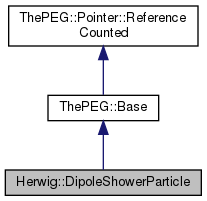|
Herwig 7.3.0
|
#include <DipoleShowerParticle.h>

Public Member Functions | |
| DipoleShowerParticle () | |
| Default constructor. | |
| ~DipoleShowerParticle () | |
| Default destructor. | |
| void | clear () |
| Reset the member variables of the object. | |
| void | prepare (PPtr &part, const Helicity::Direction emmDir, const Helicity::Direction specDir, const Lorentz5Momentum &pVector, const Lorentz5Momentum &nVector) |
| Set up the decay vertex for the emitter. | |
| DSVertexPtr | decayVertex () |
| Return the associated decay vertex, a DipoleShowerVertex. | |
| vector< LorentzSpinor< SqrtEnergy > > | createFermionDecayStates () |
| Create fermion decay basis states. | |
| void | createVectorDecayStates () |
| Create vector decay basis states. | |
| void | createNewFermionSpinInfo (PPtr &outgoing, Helicity::Direction dir) |
| Create fermion production basis states for the given particle produced in the splitting. | |
| void | createNewVectorSpinInfo (PPtr &outgoing, Helicity::Direction dir) |
| Create vector production basis states for the given particle produced in the splitting. | |
| void | setFermionMapping (const vector< LorentzSpinor< SqrtEnergy > > &decayBasis) |
| Create the mappings between the production and decay states for the fermion and store them in the associated decay vertex. | |
| void | setVectorMapping () |
| Create the mappings between the production and decay states the boson and store them in the associated decay vertex. | |
 Public Member Functions inherited from ThePEG::Base Public Member Functions inherited from ThePEG::Base | |
| void | debug () const |
| virtual void | debugme () const |
 Public Member Functions inherited from ThePEG::Pointer::ReferenceCounted Public Member Functions inherited from ThePEG::Pointer::ReferenceCounted | |
| CounterType | referenceCount () const |
Static Public Member Functions | |
| static void | Init () |
| The standard Init function used to initialize the interfaces. | |
 Static Public Member Functions inherited from ThePEG::Base Static Public Member Functions inherited from ThePEG::Base | |
| static void | Init () |
Private Member Functions | |
| DipoleShowerParticle & | operator= (const DipoleShowerParticle &)=delete |
| The assignment operator is private and must never be called. | |
Private Attributes | |
| PPtr | theParticle |
| The pptr to this particle. | |
| DSVertexPtr | theDecayVertex |
| The dipole shower vertex associated with this particle. | |
Additional Inherited Members | |
 Public Types inherited from ThePEG::Pointer::ReferenceCounted Public Types inherited from ThePEG::Pointer::ReferenceCounted | |
| typedef unsigned int | CounterType |
 Public Attributes inherited from ThePEG::Pointer::ReferenceCounted Public Attributes inherited from ThePEG::Pointer::ReferenceCounted | |
| const unsigned long | uniqueId |
 Protected Member Functions inherited from ThePEG::Pointer::ReferenceCounted Protected Member Functions inherited from ThePEG::Pointer::ReferenceCounted | |
| ReferenceCounted (const ReferenceCounted &) | |
| ReferenceCounted & | operator= (const ReferenceCounted &) |
Detailed Description
Definition at line 31 of file DipoleShowerParticle.h.
Constructor & Destructor Documentation
◆ DipoleShowerParticle()
|
inline |
Default constructor.
Definition at line 38 of file DipoleShowerParticle.h.
◆ ~DipoleShowerParticle()
|
inline |
Default destructor.
Definition at line 43 of file DipoleShowerParticle.h.
Member Function Documentation
◆ createFermionDecayStates()
| vector< LorentzSpinor< SqrtEnergy > > Herwig::DipoleShowerParticle::createFermionDecayStates | ( | ) |
Create fermion decay basis states.
It returns the decay basis states in the decay frame as required for the mapping.
◆ decayVertex()
|
inline |
Return the associated decay vertex, a DipoleShowerVertex.
Definition at line 65 of file DipoleShowerParticle.h.
References theDecayVertex.
◆ Init()
|
static |
The standard Init function used to initialize the interfaces.
Called exactly once for each class by the class description system before the main function starts or when this class is dynamically loaded.
◆ operator=()
|
privatedelete |
The assignment operator is private and must never be called.
In fact, it should not even be implemented.
◆ setFermionMapping()
| void Herwig::DipoleShowerParticle::setFermionMapping | ( | const vector< LorentzSpinor< SqrtEnergy > > & | decayBasis | ) |
Create the mappings between the production and decay states for the fermion and store them in the associated decay vertex.
(No longer applicable) reason for passing the decay states as an argument: Previously used a check on zero values for computing the mapping, rather than a </> 1e-5, this would only work when using the original decay state as calculated in the decay frame (i.e. without transforming to the lab frame and back). Now it simply avoids doing an unnecessary rotation of the decay basis
Member Data Documentation
◆ theDecayVertex
|
private |
The dipole shower vertex associated with this particle.
Definition at line 135 of file DipoleShowerParticle.h.
Referenced by decayVertex().
◆ theParticle
|
private |
The pptr to this particle.
Definition at line 129 of file DipoleShowerParticle.h.
The documentation for this class was generated from the following file:
Generated on Thu Jun 20 2024 17:50:55 for Herwig by